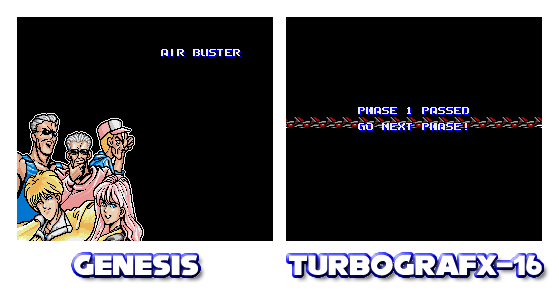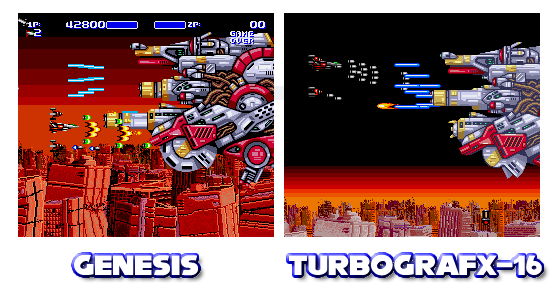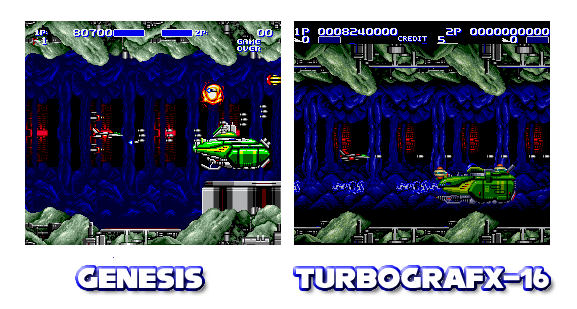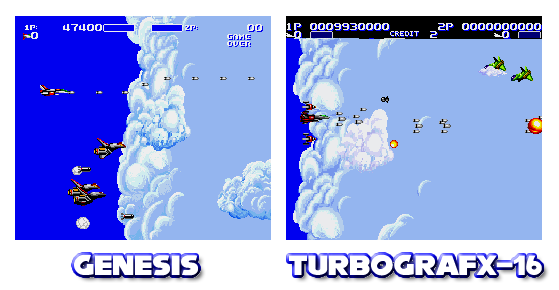If you have a passion for things that are a bit better than mediocre, then Air Buster/Aero Blasters is/are the game(s) for you! In 1990 NEC released Aero Blasters for the TurboGrafx-16 which was programmed by Hudson Soft in Japan. It allowed anywhere from 1 all the way up to 2 players to play simultaneously. Since there were no death matches or capture the flag modes, the multi-player mode was almost completely ignored. After selling almost a dozen copies in the U.S. (that’s nearly 50% of all TurboGrafx-16 owners), Kaneko saw what a major hit this game was and decided to release a Genesis version, but this time they would release the game themselves and they decided it would happen in the fabled year of 1991. They changed the name of the game to Air Buster just to piss me off. In fact during a recent telephone survey conducted at the dinner hour, 100% of the respondents claimed that they greatly preferred the name Aero Blasters to Air Buster. So we have Air Buster on the Genesis, and Aero Blasters on the TurboGrafx-16. It is the mission of this article to compare them to each other and see once and for all which one sucks the least!
The Differences
Presentation: Both games have a similar presentation… Phase One followed by Phase Two, etc. Both allow for two players. But the Genesis offers a loading screen with some idiotic anime characters before each level which cannot be skipped. This gives players the impression that they are playing a slow CD-ROM game with 1/2x loading speed. You do not have to endure this on the mighty TurboGrafx-16. The Turbo’s processor is so blazingly fast that the next level starts right away! Also the Turbo version has some intro graphics that pop up before the title screen, complete with background sound. The wimpy Genesis system simply is not powerful enough to include these screens or any screens like them. This really shows off the massive strength of the TurboGrafx-16 video entertainment supersystem. The Turbo version also has something that the Genesis version does not… an ending! Whereas the Genesis simply scrolls the credits and then gives you the GAME OVER screen, the TurboGrafx-16 gives you a simple ending sequence, complete with actual graphics! Then the game loops and becomes more difficult. Like the intro sequence, the Genesis simply was not built to handle this kind of awe-inspiring power. Only the Turbo has enough power for this. Power plus!

Edge: Turbo Grafx-16
Graphics: The two games look very similar to each other, but the Genesis generally has bigger sprites, and more of them onscreen as well. Not only that, but the Genesis version typically has an extra background layer which makes it look nicer. A couple of good examples of this are the large buildings in Phase One which are tiny on the Turbo version, and the background in the tunnels in Phase Two which is just black on the Turbo. I must admit that the final part of Phase Six looks more impressive on the TurboGrafx-16, with at least 3 independently scrolling (vertically, anyway) layers as you move your ship up and down. The Turbo also has a few more colors onscreen at any given time, though often it is hard to tell. The bosses are generally a bit bigger on the Genesis as well due to that machine’s immense true 16-bit power. One spot which clearly the Genesis wins is the “Phase Clear” screen in which your ship zooms off to the next level, leaving a trail of ships behind without any flicker whatsoever. In the Turbo version, only 17 ships appear across the screen in a horizontal line. The Genesis has over 64 ships appear which really showcases the Genesis’ unfathomable and unlimited graphic power. I’m sure this screen made many people choose to buy the Genesis over the wimpy TurboGrafx-16 back in the day.

Edge: Genesis
Sound/Music: The game has some decent tunes, nothing amazing but they aren’t bad at all. I definitely prefer how the music sounds on the Turbo version, however. It seems smoother and more pleasant. The Genesis version uses an instrument set that is quite mundane and not up to other Genesis games of the time. Plus the TurboGrafx-16 card has a completely different tune for Phase Two that is much better compositionally than what is present in that part of the game in the Genesis version. As for the sound effects, both are pretty much average. But the sounds that the skinny moving pillars in Phase Six make as they go up and down sound far better on the Genesis than they do on the Turbo. If you have more than one speaker hooked up to your game system, both versions can take advantage of this newfangled “stereo” sound that is beginning to become popular. Since I am more biased towards music than a single sound effect, I will give the Turbo the edge here.
Air Buster Phase 1 theme (MP3 format, 1.15 megs) Aero Blasters Phase 1 theme (MP3 format, 806 kb)
Air Buster Phase 2 theme (MP3 format, 1.73 megs) Aero Blasters Phase 2 theme (MP3 format, 1.17 megs)
Edge: Turbo Grafx-16
Gameplay: Both versions are the same basic game from beginning to end as far as playing it goes. However I feel that the TurboGrafx has slightly tighter control whereas the Genesis version, for some odd reason, feels a bit more “loosey-goosey.” During Phases Four and Five you are in outer space and the control goes to hell on both versions since you suddenly have momentum and it is hard to stop. However the Genesis version goes to a far lower level of hell since if you barely touch the controller, your ship can slide all the way across the entire screen. The Turbo only slides a few ship-lengths. While playing I kept getting frustrated at the Genesis version and I thought it was harder, but in actuality it is easier than the Turbo game, though neither version is a walk in the park. Overall playing the Turbo version is a more pleasant experience until you get to Phase Six. Once there you’ll find that the screen scrolls up and down suddenly for no reason at all. This does not happen in the Genesis version. It caused me a few extra deaths. There are also a few different stage layouts here and there, such as more tight spots to fit through during the green part of Phase Two on the Turbo version. But thanks to the tighter control it’s not a gigantic issue. One thing that is very frustrating about the Genesis cart is that when you die you must wait for what seems like ten seconds while the game slowly positions your new ship in the center of the screen before you are given control. This can make you miss out on getting that power up you now desperately need. You are given control almost immediately in the Turbo version.

Edge: Turbo Grafx-16
Other: Well, according to the manuals both games take place during the same year, but in the Genesis version Charles K. Takeda goes to an “unknown” island in the Pacific ocean to build the Air Buster project. In the Turbo version he goes to a “secluded” island in the Atlantic ocean. This can be a deal breaker for some people, especially for fans of the Indian, Arctic or Southern oceans. Gulf of Mexico fans probably won’t be too happy, either. But if you like the Pacific or Atlantic oceans, just choose the version of the game which best suits your needs on this issue. One thing the Turbo version offers is the ability to call the TurboGrafx Hotline at (708) 860-3648 for additional game playing tips. This does not work for the Genesis version and you will find your phone call ended with an abrupt hang-up. The Genesis version leaves you out in the cold with no tip line at all. Also let’s not forget the box art. The Turbo version looks good, but nothing amazing. The yellow Genesis cover is simply putrid in all respects. If you put this up on your shelf and you have company over, you will most likely find yourself the recipient of a severe beating. But once you open up the Genesis box you’ll see a very nice looking manual. This should have been the box art, logo and all. Last but not least is the free offer for the Kaneko video game glove in the Genesis game. Perhaps this was to make up for having no tip line, because this glove gives players the ultimate edge! Unfortunately the glove does not work with the TurboGrafx version.

Edge: Draw
Final Assessment
 Personally I’d go with the Turbo version as all in all I feel it is better, especially the controls and the music. But the Genesis interpretation has nicer graphics with that extra layer of scrolling and bigger sprites.
Personally I’d go with the Turbo version as all in all I feel it is better, especially the controls and the music. But the Genesis interpretation has nicer graphics with that extra layer of scrolling and bigger sprites.
Although neither game may be a “must-have” for most people, if you want to add it to your collection then you shouldn’t feel too bad if you have one version or the other. The differences aren’t huge, and only nitpicking fanboys will stress the differences. But keep in mind that nitpicking fanboys may be the world’s most precious natural resource. (Click on the thumbnail for a larger image of the famous “Video Glove” offer!)

Recent Comments